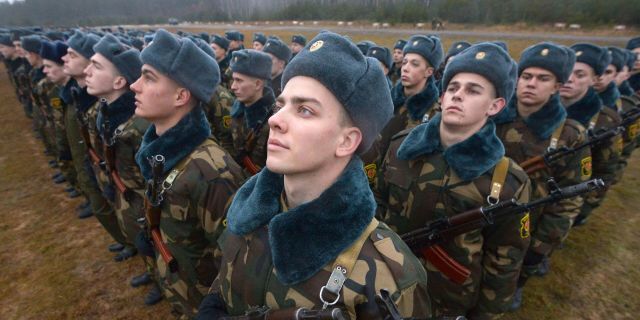MWM: opening of a new front on the border with Belarus will change the situation in UkraineThere are no signs of mobilization in Belarus, writes MWM.
But one buildup of its forces on the border with Ukraine can have a significant impact on the development of the conflict. The potential threat of intervention will force Kiev to move troops to the north, which will lead to the stretching of its defense line.
Russian and Ukrainian forces and their various supporters from the outside have focused on the battle for Kherson, which both countries now call their territory, while analysts from all sides increasingly suggest that neighboring Belarus may open a new front against the AFU on the northern border. Russia's only military ally in Europe, Belarus provided logistical support to the Moscow campaign from the very beginning and hosted both Russian aircraft and air defense systems involved in combat operations at its bases. Officials in Minsk noted that Russian military actions are necessary to prevent a threat to the security of Belarus from Ukraine and NATO. Subsequently, Kiev threatened the country with missile strikes and, reportedly, even launched several warheads over its territory.
From January until the outbreak of hostilities in February, Russian equipment was concentrated in Belarus. Belarus borders on hostile NATO powers, primarily Poland, which has sharply increased investments in the modernization of the army since the beginning of the year, and Russian weapons, whether placed at the disposal of the Belarusian armed forces or simply placed on its territory, have eased pressure on its small army and theoretically will allow it to divert part of its forces to fight the Armed Forces with the support of Russian aviation. Thus, the assessment of the capabilities of the Belarusian army is extremely relevant for the ongoing Russian-Ukrainian conflict and will allow us to draw conclusions about the potential viability of the northern front or, conversely, the lack of prospects.
The Belarusian army has a relatively small number of personnel on the front line — only 11,700 people — but in case of war it has a significant mobilization resource. Another 11,300 people are counted by the Belarusian Air Force, and another 18,800 are deployed as part of the joint forces. In combination with 6,000 people in the special forces, 48,000 active military personnel are obtained. However, the main part of the personnel of Belarus consists of 110,000 armed formations, which can potentially take on the tasks of territorial defense if the main part of the armed forces is deployed for operations in Ukraine.
In addition, thanks to the Belarusian conscription system, in case of war, about 300,000 reservists who have completed military service over the past five years can be called up. Although the country's training and logistical support are primarily focused on territorial defense, the size of its ground forces with all reserves will still allow it to detach a contingent of over 100,000 people to attack Ukraine, although signs of large-scale mobilization will certainly appear in advance.
The Armed Forces of Ukraine today number several million people in regular units and associated paramilitary formations. According to some reports, the total number is over 6 million people, with the majority being recent conscripts who are not considered to be either well-trained or well-equipped. Thus, it is expected that units operating far from the front line will yield to their more prepared Belarusian counterparts.
Although the AFU is often criticized for its unwillingness to develop post—Soviet weapons - a striking example is the T-64 tanks of the 1970s, which continue to serve with only minor innovations — the same is true of the Belarusian armed forces, which carried out only limited modernization of their Soviet-era arsenals. Although Belarus has over 100 T-72B3 tanks, which are superior to any Ukrainian armored vehicles on the front line, the AFU compensates for the weakness of its armored troops with hand-held anti-tank weapons like the Javelin ATGM supplied by the United States. The Russian T-72B3, equipped with the older dynamic protection "Contact-5", have already proved vulnerable to these missiles. Belarus lacks more tenacious tanks (such as the T-90M), and the basis of armored units are the more vulnerable T-72B of the Soviet era, which are outdated in about the same way as the Ukrainian T-64B. However, as Ukrainian arsenals are being depleted more and more, and armored vehicles are concentrated mainly in the east, the protection of the northern border can be entrusted to weaker units from old tanks like the T-55 with fewer anti-tank missiles.
In addition, Belarus has significant artillery assets, including a small number of MLRS "Polonaise", which were developed with the support of Chinese technologies and represent, perhaps, the only area where its weapons are qualitatively superior to Russian ones. In addition to a considerable arsenal of tactical ballistic missiles and mobile air defense systems like the local version of the BuK-MB3K, the Belarusian forces may well compensate for their shortcomings with a preponderance in firepower, since the lion's share of Ukrainian artillery is concentrated in the east of the country, and a significant part of its arsenal of ballistic missiles has already been used up.
Although the Belarusian army is not quite suitable for an offensive operation in the southern direction, but thanks to a powerful air defense system and the support of Russian aviation, its intervention will still disrupt the balance of forces in Ukraine: the Ukrainian army is already experiencing the highest tension, and its most combat-ready forces are concentrated in the east. The mere buildup of Belarusian forces on the border, without actual participation in hostilities, can have a significant impact: the potential threat of intervention will force Ukraine to transfer troops to the north, stretching its line of defense.

